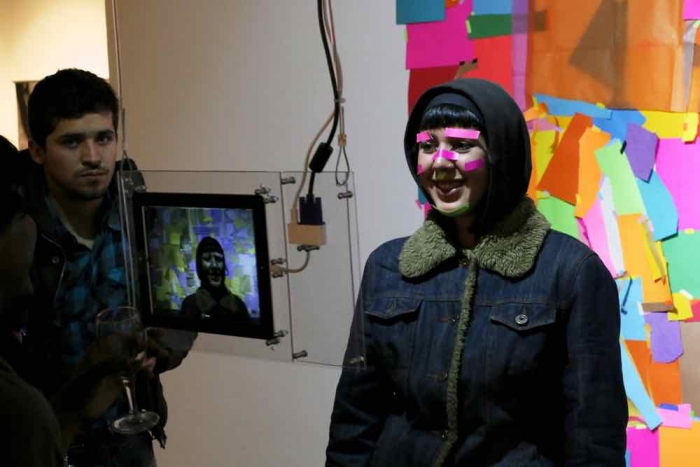You, Me & They Portraying Us at the José Drudis-Biada Art Gallery on the campus of Mount Saint Mary’s University Los Angeles (October 25-November 26, 2020) employs curatorial activism as a mode of inquiry to challenge the assumptions and erasures of voices in hegemonic narratives. In this exhibition, artists included portray their multifaceted identities, sometimes interwoven with their psychological struggles and further complicated by public perceptions of who they are, should be, or could be. Working across the mediums of painting, social media, performance, sculpture, papermaking, and crafting, their work questions portraiture as a restricted intellectual idea and artistic medium of portrayal. It posits the concept of portraiture as a dynamic and performative self to query how one sees and represents oneself, the subjectivity of perceiving others, and what results from the relationship between these two modes of reflection.
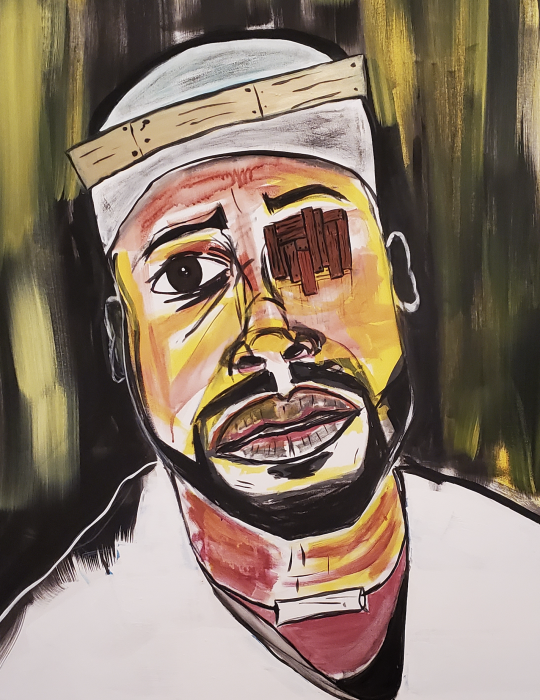
James Shawn Crum, Detail of Melancholy, 2019 (Acrylic on Canvas) (60″ x 48″)
To facilitate the creative transformation process as he painted the self-portraits included in the exhibition, James Shawn Crum intertwined narratives from Classical mythology with African legends warning of feuding brothers’ misadventures and demise. These interlaced stories are painfully evident in Crum’s compositions on exhibit, none more so than his psychological self-portrait Melancholy, 2019, in which his feelings of otherness are papabile. Symbolized by a beleaguered facial expression and one eye boarded shut, his fear of being seen while seemingly pleading with spectators to see and consequently value his humanity as a black man living in America.
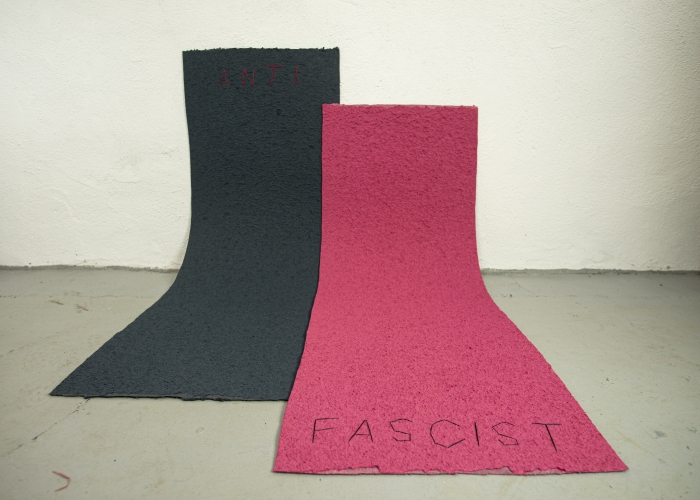
Xarabyte, Sprayings 1& 2 (State of Affairs), 2020 (Recycled Cotton on Fiberglass Screen with Embroidery Thread) (40″ x 60″)
This sentiment of being othered is shared by Xarabyte in their red and black diptych Sprayings 1& 2 (State of Affairs), 2020. They shredded clothing to create a paper pulp, which produced an activated surface in their handmade paper panels. This visceral quality, coupled with the handstitched “ANTI” in red thread on the left black panel and “FASCIST” in black thread on the right red panel, expresses Xarabyte’s desire for human equality. The work is reminiscent of the antifascist flag associated with Antifa, a loose movement of activists who demonstrate against authoritarian, racist, xenophobic, homophobic, and othered communities.
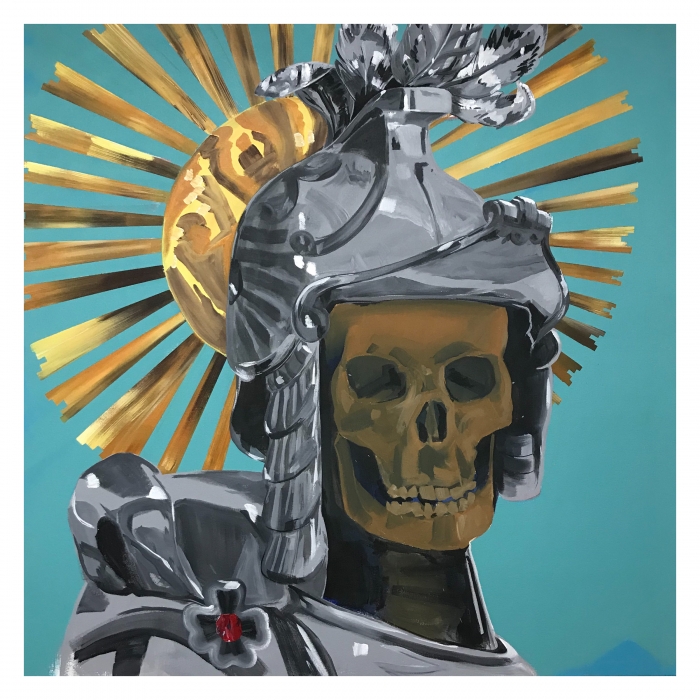
Mark Batongmalaque, All That Remains, 2020 (Acrylic on Canvas) (47″ x 47″)
Mark Batongmalaque challenges himself to represent beauty, death, and the ephemeralness of their coexistence. The profile skeleton staring into the eyes of a figure in The Painful Path of Empathy, 2019, conveys humanity’s shared experiences of grasping at these moments as they slip through our fingers, fading into memory, and our struggles to understand someone else’s pain. Dressed in a royal purple robe with folds of drapery framing its smiling chipped tooth grinning face accentuates the bedazzled floral crown and neck cuff worn by the skeleton in We Only Matter to Us, 2020. This painting and the portrait of a skeleton in All that Remains, 2020, dressed as a knight wearing armor designed with Art Nouveau flair and framed by a dazzling Baroque sort of halo, evoke seventeenth-century Dutch vanitas theme paintings. Yet, Batongmalaque’s absurdist humor juxtaposing the underbelly of vanity exemplified by skeletons with fanciful pop culture interpretations of art historical imagery ingratiates viewers and encourages us to reflect on the brevity of life, like the Dutch painters intended.
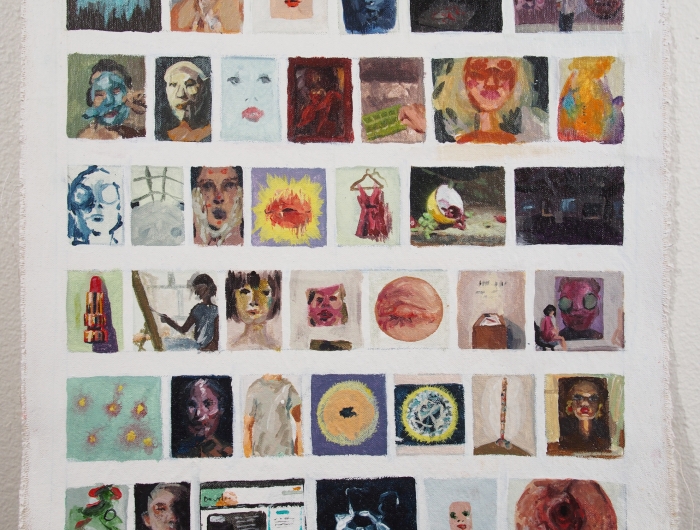
Megan Koth, Detail of Interface II: Google Images, 2020 (Oil on Canvas) (15″ x 70″)
Megan Koth followed posts suggested by her Instagram feed and Google image results from searching her name to formulate a wormhole linking more and more disparate content to her identity the further she burrowed. She appropriated these mediated photos of herself, her paintings, her friends, and then unrelated imagery seemingly inexplicably associated with her name to craft “self-portraits” in her Interface, 2020, paintings. The resulting scrolls of diminutive faces read like a visual diagram. The process of working in her studio to paint a mediated detail of her paintings, the actual compositions stored a few feet away, creates a dynamic self-referential relationship both in her creative process and spectatorship.
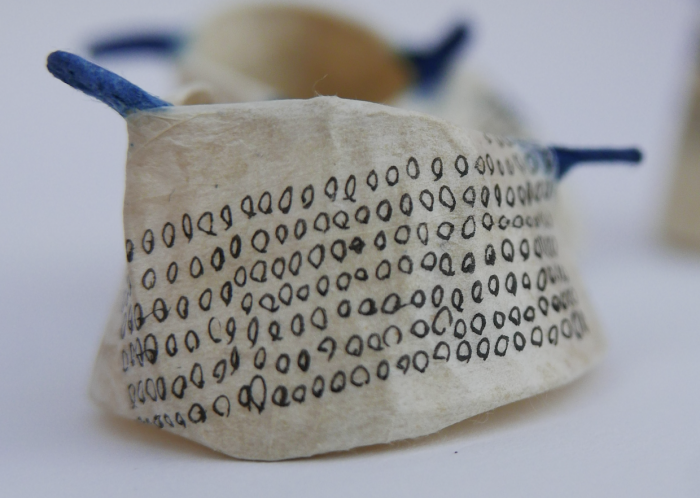
Thu Kim Vu, Detail of The world in my vessels, 2019 (Ink on Washi Paper) (1.6″ x 1.6″ x 1.2″)
Thu Kim Vu’s sculptural work The world in my vessels, 2019, comments on gatherings and missing friends and family during the pandemic lockdown. Vu handmade miniature sculptures from Washi paper shaping them like kitchenware. She then drew elaborate motifs on each vessel—a code for each imaginary person invited to her dinner party. The world in my vessel reminds us that conversations and stories shared over meals enrich our lives and strengthen our communal bonds.
We look forward to gathering for dinner parties with friends and family post-pandemic and conversing about how to rebuild a more inclusive society.
Jennifer Vanderpool, Ph.D.
Los Angeles, California
October 2020
